Year (So Far) In Review: JT Miller’s MVP Season

On June 22, 2019 – the second day of the 2019 NHL Entry Draft, held in Vancouver – the host Canucks acquired JT Miller from the Tampa Bay Lightning, sending Marek Mazanec, a 2019 third round pick, and a conditional first round pick in either 2020 or 2021 in return.
To say that the trade was controversial at the time would be an enormous understatement. For many, giving up a first round pick, and potentially a high one at that, for a player that Tampa needed to get rid of to clear cap space seemed like an overpayment.
One season later, there remains some uncertainty in regards to the transaction – it’s still yet to be determined which first round pick Vancouver will be losing, for instance – but anyone who watched the Canucks play in 2019/20 is now sure of one thing, and that’s that JT Miller was absolutely worth the price Jim Benning paid for him.
In our Year (So Far) In Review below, we’re going to break down some of the facts and fictions of Miller’s stellar first season in Vancouver, and why some are touting him as the team’s MVP.
Fact: JT Miller Just Had The Best Season Of His Career
There’s little debate when it comes to asserting that JT Miller just enjoyed the best season of his career at the age of 27 – just take a look at the raw numbers.
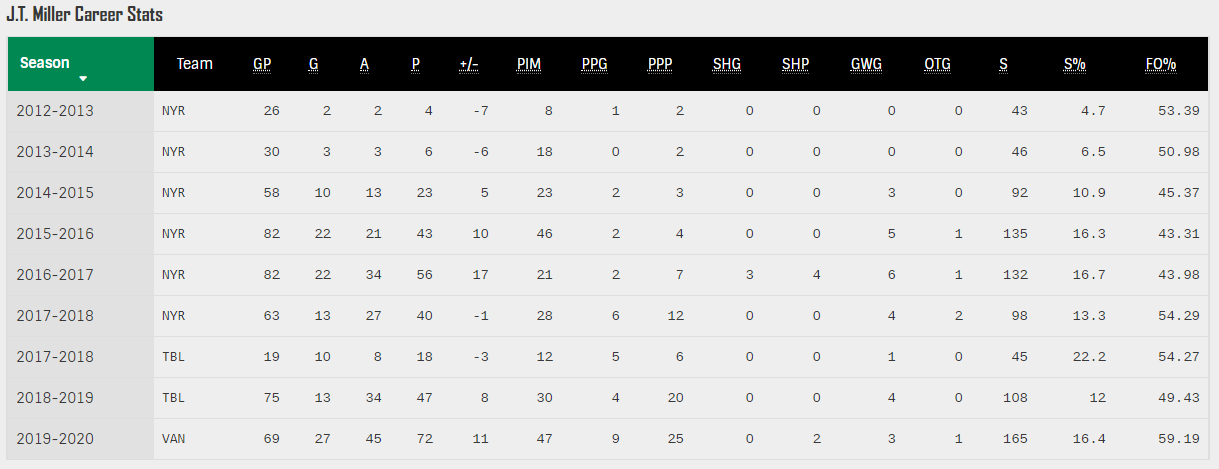
From NHL.com
Miller achieved career highs in goals, assists, points, and even faceoff percentage – and he did it all in just 69 games, the lowest amount he’s played since the 2014/15 season.
This is made all the more impressive in the context of Miller’s 2018/19 performance with the Lightning, in which he scored just 13 goals and often found himself lost amidst Tampa’s stacked forward corps.
Some players merely bounce back from a down season – but JT Miller slingshotted his old standard and drove his career to some astonishing new heights.
Fact: JT Miller Was One Of The League’s Best Forwards In 2019/20
When he was acquired by the Vancouver Canucks, some questioned whether he truly represented an upgrade in the top-six over established options like Tanner Pearson, Nikolay Goldobin, and Sven Baertschi. Miller proceeded to make a mockery of any such worries.
Put simply, Miller was one the best forwards in the entire NHL throughout the 2019/20 season, and he has the stats to prove it.
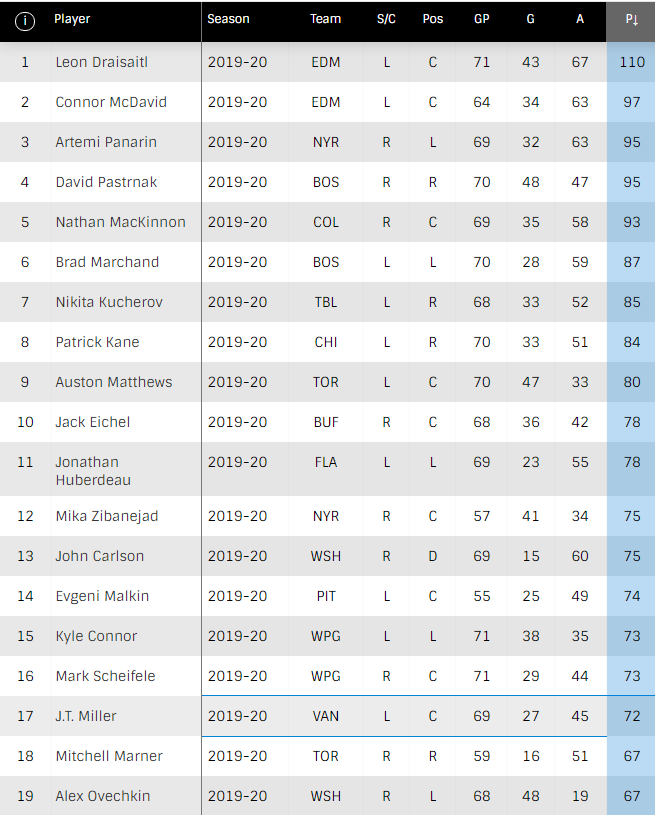
From NHL.com
When the NHL suspended play in March, Miller sat 17th overall in the league scoring race with 72 points. Miller scored more points this season than a long list of NHL luminaries, including Alex Ovechkin, John Tavares, Aleksander Barkov, and Miller’s former teammate Steven Stamkos.
Obviously, Miller’s final rank has something to do with the fact he stayed healthy all season, but not as much as one might think.
With a 1.04 points-per-game average, Miller ranked 19th overall among NHLers who played more than ten games this season. That still puts him ahead of the Ovechkins, Tavares’, and Barkovs of the world – and well ahead of any of his Vancouver teammates, which we’ll get to in a moment.
All of which goes a long way toward justifying the assertion that JT Miller was one of the NHL’s top-20 forwards in 2019/20, and there’s more evidence available that suggests he should be even higher on the list.
Miller’s Relative Corsi For Percentage at even-strength, which compares Miller’s possession contributions to those of his teammates, was 8.6% – which doesn’t sound all that impressive, until it’s put into context.
Only four other players in the entire league who played 20 games or more in 2019/20 had a better Relative Corsi score; Anthony Mantha, Andrew Agozzino, Tomas Tatar, and Elias Pettersson.
And speaking of Pettersson, that leads us nicely to our next point.
Fiction: JT Miller Rode Elias Pettersson’s Coattails
There should be no room left to doubt that JT Miller just had a breakout season – but there are some who will still question how much credit Miller himself deserves for it. He did, after all, spend the majority of the year riding shotgun with Elias Pettersson, another player who solidified himself as a truly elite talent in 2019/20.
Some would go as far as to say that Miller rode Pettersson’s coattails to a bevy of career highs – but that’s just not true.
Sure, Miller spent plenty of time on Pettersson’s wing, but it only represented 65.3% of his minutes at even-strength, to be exact.

And how many of Miller’s points came from his time with Pettersson? About 77% of them.

From Dobber’s Frozen Tools
In other words, Miller benefitted from playing with Pettersson, as anyone would, but Pettersson wasn’t solely responsible for Miller’s scoring increase.
To wit, Miller spent about 14.7% of his even-strength minutes on a line with Bo Horvat, and picked up 13.3% of his even-strength points during that time.
Miller was productive no matter where he was placed in the lineup – it just so happens that he was slightly more productive when he played on the top line. Go figure.
He was also remarkably consistent throughout the year, as evidenced by his quarterly breakdown.

From Dobber’s Frozen Tools
Fiction: JT Miller Had An Unsustainable Season
Whenever a player scores at a rate way over and above their typical performance, there are always claims thrown around that the player is just enjoying an extended streak of luck – and that their numbers are unsustainable and will come crashing back down to Earth eventually.
That does not appear to be the case when it comes to JT Miller and his 2019/20 season.
The first clue that a player might be having a lucky year is an abnormally high shooting percentage, which would thus indicate that said player is benefitting from a lot of fortunate bounces.
Miller’s shooting percentage in 2019/20 was 16.4%, which is higher than that of the average NHL forward, but right in line with Miller’s own career average of 14.1%.
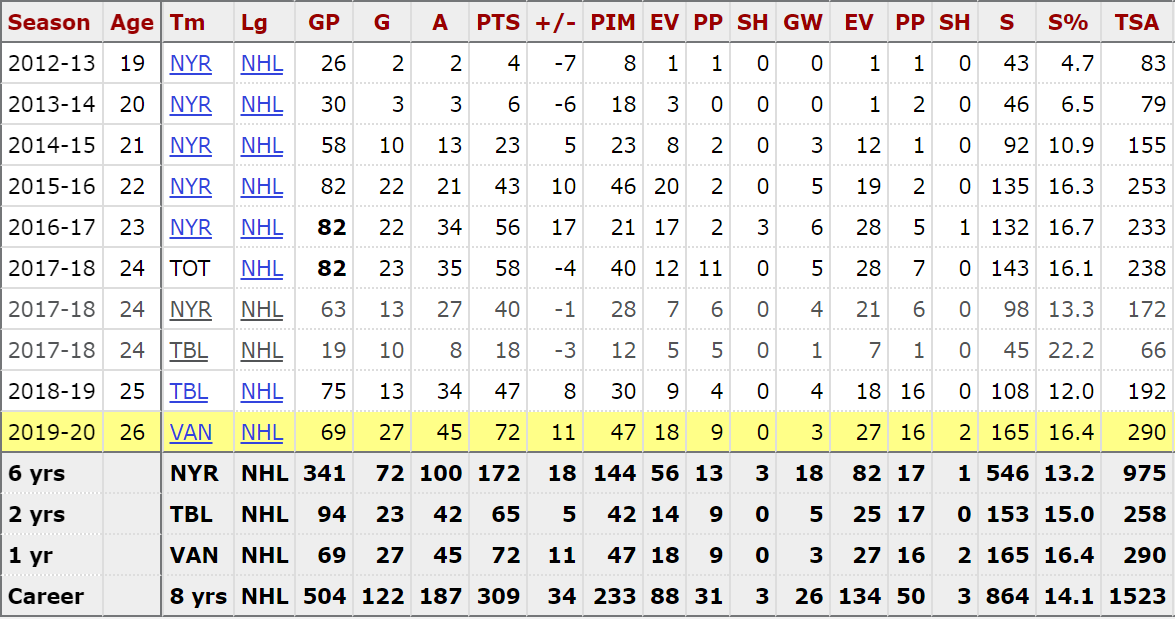
From Hockey-Reference.com
In fact, Miller has carried a shooting percentage of 16% or greater in each of his five full seasons in the NHL, with the exception of last year’s rate of 12%.
If anything, those numbers suggest that Miller was the victim of an unlucky season in 2018/19, and that 2019/20 was merely a return to his baseline.
The real difference-maker appears to be ice-time. Miller averaged 20:06 for the Canucks this season, easily the most he has played in his career. The only other time Miller received minutes close to that was during his first stint with the Lightning after being acquired in 2018 – he played an average of 18:11 then and put up 18 points in 19 games.
JT Miller wasn’t lucky in 2019/20, he just made the most of an increased opportunity – and as long as that opportunity remains open, his performance should absolutely be sustainable.
Fiction: JT Miller Sacrificed Defense To Reach New Offensive Heights
JT Miller was touted as a two-way force when he arrived in Vancouver, and he’s done nothing to dissuade that reputation, even as his offensive profile has grown. He certainly doesn’t seem to have made any sacrifice on the defensive side of the puck in the name of increasing his production.
Miller’s possession numbers alone, in which he was consistently neck-and-neck with Elias Pettersson for the team lead, should be a powerful indication of how well Miller controls the game. The Canucks’ rate of Expected Goals shoot through the roof whenever Miller is on the ice.
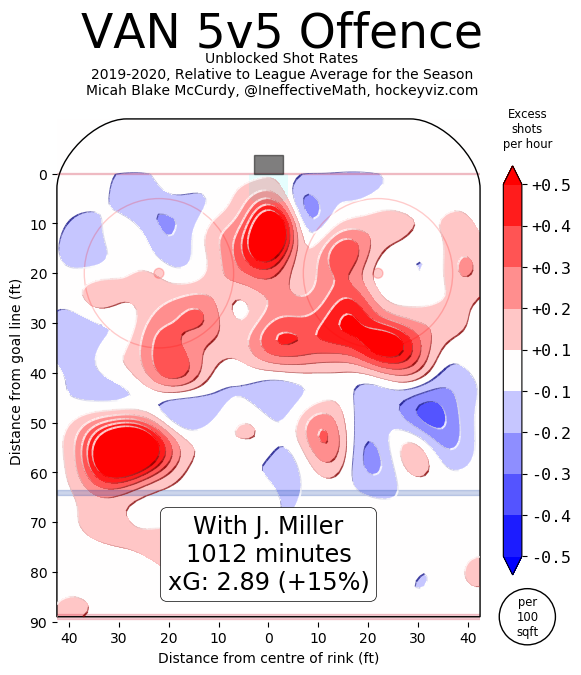

From HockeyViz.com
Miller’s defensive impact, however, is just as noticeable. Miller and his linemates suppress shots and greatly reduce their opponents’ scoring chances – and the rate of Expected Goals against the Canucks drops dramatically whenever Miller steps off the bench.
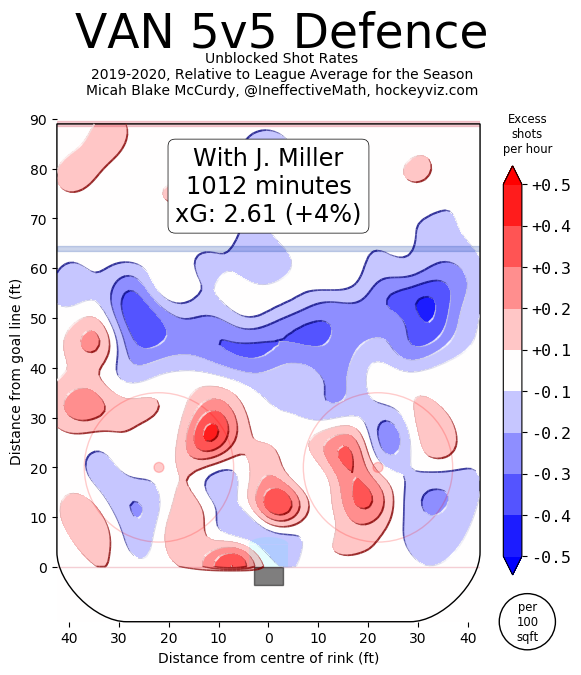
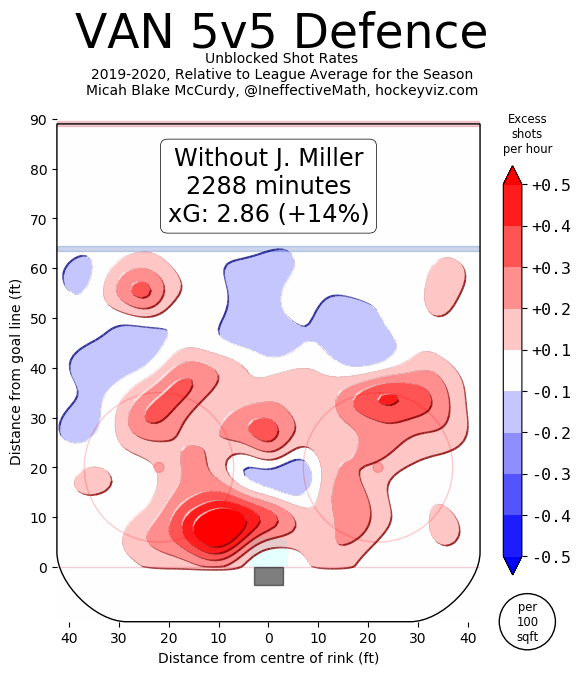
From HockeyViz.com
And it’s all the more notable given the context of the competition that Miller and his linemates regularly face. It became obvious this season that Miller should be a part of the Canucks’ core moving forward – a core that is conveniently visually highlighted by the following graph, based on Rob Vollman’s Player Usage Chart.
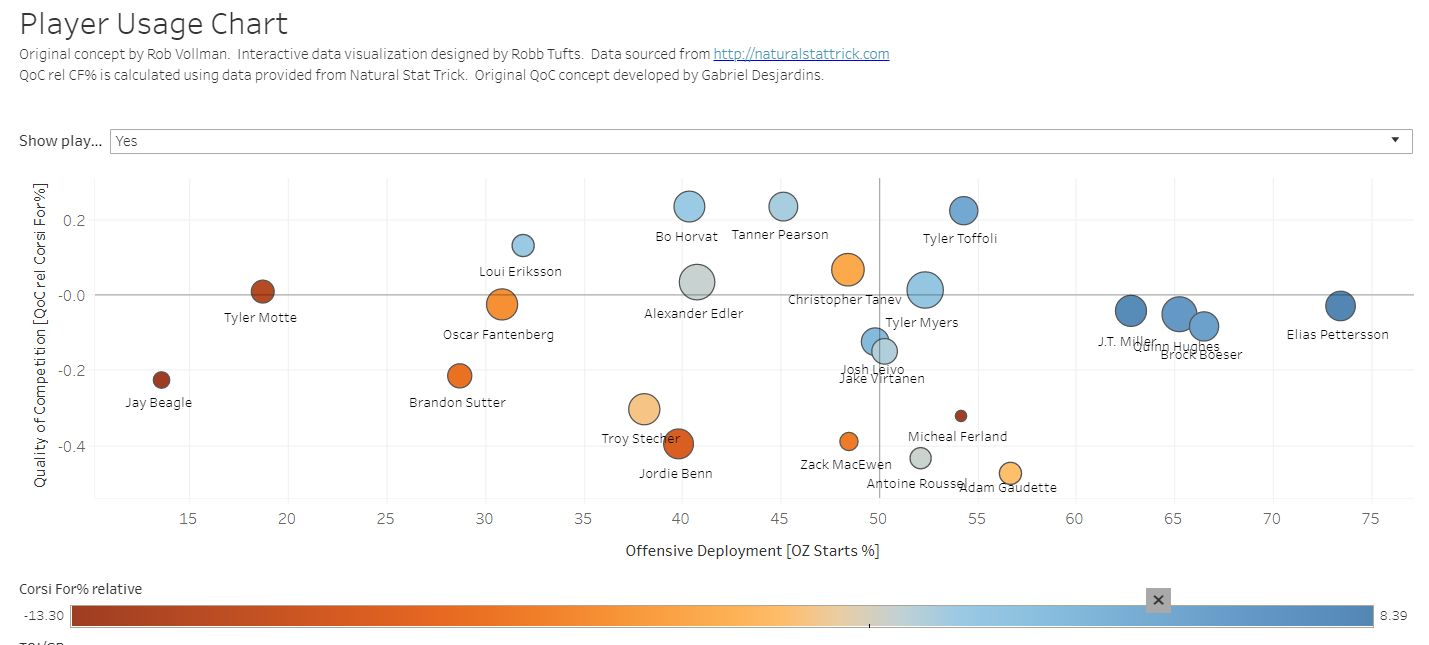
From Dobber’s Frozen Tools
Fact: No Player Contributed More To The Canucks’ Success In 2019/20 Than JT Miller
There are a few other candidates out there for the Canucks’ MVP in 2019/20 – Elias Pettersson, Quinn Hughes, and Jacob Markstrom all qualify – but no one contributed more to the team’s success than JT Miller.
He scored six more points than Pettersson in just one more game. No other Canuck came anywhere close to Miller’s rate of production – Vancouver’s third leading scorer, Bo Horvat, trails Miller by 19 points.
Miller played more minutes than any other forward and was a staple on the first powerplay unit. He also put in some time on the penalty kill while Brandon Sutter and Jay Beagle were out, and performed admirably.
Miller even led the Canucks in hits, with 123 across 69 games. He took on Matthew Tkachuk to stick up for Elias Pettersson. He even proved capable in the shootout, where he scored what now stands as Vancouver’s final goal of the year – a play that probably would have been looked at as crucial to the Canucks’ playoff run, had they been allowed to make one.
JT Miller’s arrival in Vancouver pushed his career to new heights, but it also did the same for the franchise as a whole.
And that’s why he was the team’s most valuable player in 2019/20 – and why the odds are good he’ll continue to be an important part of the core for years to come.
Recent articles from Stephan Roget





